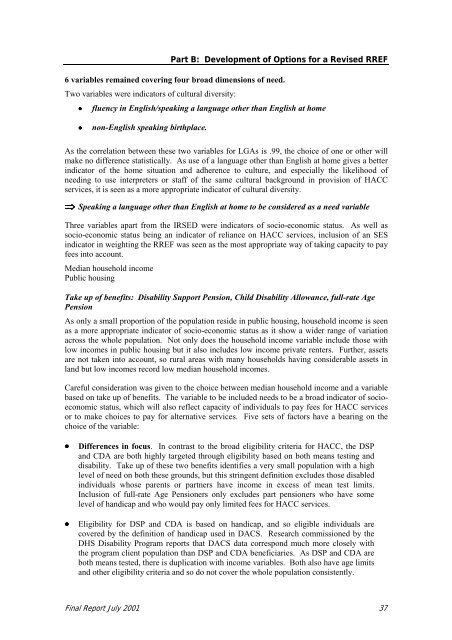Final Report on RREF 2001 - Department of Health
Final Report on RREF 2001 - Department of Health
Final Report on RREF 2001 - Department of Health
Create successful ePaper yourself
Turn your PDF publications into a flip-book with our unique Google optimized e-Paper software.
Part B: Development <strong>of</strong> Opti<strong>on</strong>s for a Revised <strong>RREF</strong><br />
6 variables remained covering four broad dimensi<strong>on</strong>s <strong>of</strong> need.<br />
Two variables were indicators <strong>of</strong> cultural diversity:<br />
• fluency in English/speaking a language other than English at home<br />
• n<strong>on</strong>-English speaking birthplace.<br />
As the correlati<strong>on</strong> between these two variables for LGAs is .99, the choice <strong>of</strong> <strong>on</strong>e or other will<br />
make no difference statistically. As use <strong>of</strong> a language other than English at home gives a better<br />
indicator <strong>of</strong> the home situati<strong>on</strong> and adherence to culture, and especially the likelihood <strong>of</strong><br />
needing to use interpreters or staff <strong>of</strong> the same cultural background in provisi<strong>on</strong> <strong>of</strong> HACC<br />
services, it is seen as a more appropriate indicator <strong>of</strong> cultural diversity.<br />
⇒ Speaking a language other than English at home to be c<strong>on</strong>sidered as a need variable<br />
Three variables apart from the IRSED were indicators <strong>of</strong> socio-ec<strong>on</strong>omic status. As well as<br />
socio-ec<strong>on</strong>omic status being an indicator <strong>of</strong> reliance <strong>on</strong> HACC services, inclusi<strong>on</strong> <strong>of</strong> an SES<br />
indicator in weighting the <strong>RREF</strong> was seen as the most appropriate way <strong>of</strong> taking capacity to pay<br />
fees into account.<br />
Median household income<br />
Public housing<br />
Take up <strong>of</strong> benefits: Disability Support Pensi<strong>on</strong>, Child Disability Allowance, full-rate Age<br />
Pensi<strong>on</strong><br />
As <strong>on</strong>ly a small proporti<strong>on</strong> <strong>of</strong> the populati<strong>on</strong> reside in public housing, household income is seen<br />
as a more appropriate indicator <strong>of</strong> socio-ec<strong>on</strong>omic status as it show a wider range <strong>of</strong> variati<strong>on</strong><br />
across the whole populati<strong>on</strong>. Not <strong>on</strong>ly does the household income variable include those with<br />
low incomes in public housing but it also includes low income private renters. Further, assets<br />
are not taken into account, so rural areas with many households having c<strong>on</strong>siderable assets in<br />
land but low incomes record low median household incomes.<br />
Careful c<strong>on</strong>siderati<strong>on</strong> was given to the choice between median household income and a variable<br />
based <strong>on</strong> take up <strong>of</strong> benefits. The variable to be included needs to be a broad indicator <strong>of</strong> socioec<strong>on</strong>omic<br />
status, which will also reflect capacity <strong>of</strong> individuals to pay fees for HACC services<br />
or to make choices to pay for alternative services. Five sets <strong>of</strong> factors have a bearing <strong>on</strong> the<br />
choice <strong>of</strong> the variable:<br />
• Differences in focus. In c<strong>on</strong>trast to the broad eligibility criteria for HACC, the DSP<br />
and CDA are both highly targeted through eligibility based <strong>on</strong> both means testing and<br />
disability. Take up <strong>of</strong> these two benefits identifies a very small populati<strong>on</strong> with a high<br />
level <strong>of</strong> need <strong>on</strong> both these grounds, but this stringent definiti<strong>on</strong> excludes those disabled<br />
individuals whose parents or partners have income in excess <strong>of</strong> mean test limits.<br />
Inclusi<strong>on</strong> <strong>of</strong> full-rate Age Pensi<strong>on</strong>ers <strong>on</strong>ly excludes part pensi<strong>on</strong>ers who have some<br />
level <strong>of</strong> handicap and who would pay <strong>on</strong>ly limited fees for HACC services.<br />
• Eligibility for DSP and CDA is based <strong>on</strong> handicap, and so eligible individuals are<br />
covered by the definiti<strong>on</strong> <strong>of</strong> handicap used in DACS. Research commissi<strong>on</strong>ed by the<br />
DHS Disability Program reports that DACS data corresp<strong>on</strong>d much more closely with<br />
the program client populati<strong>on</strong> than DSP and CDA beneficiaries. As DSP and CDA are<br />
both means tested, there is duplicati<strong>on</strong> with income variables. Both also have age limits<br />
and other eligibility criteria and so do not cover the whole populati<strong>on</strong> c<strong>on</strong>sistently.<br />
<str<strong>on</strong>g>Final</str<strong>on</strong>g> <str<strong>on</strong>g>Report</str<strong>on</strong>g> July <strong>2001</strong> 37
















